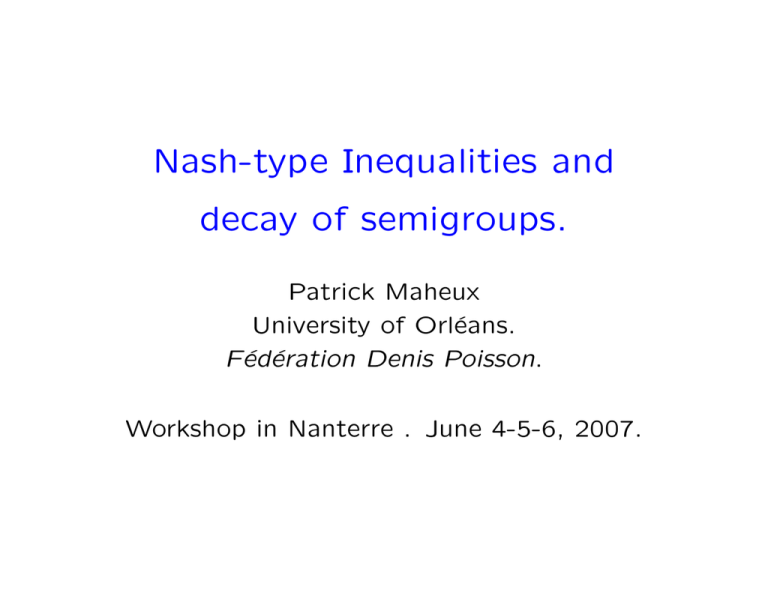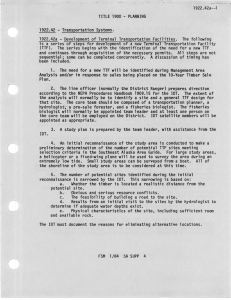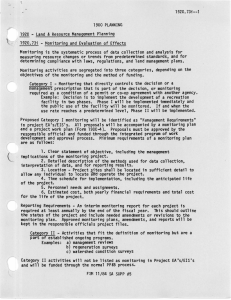Nash-type Inequalities and decay of semigroups.
advertisement

Nash-type Inequalities and decay of semigroups. Patrick Maheux University of Orléans. Fédération Denis Poisson. Workshop in Nanterre . June 4-5-6, 2007. SETTING • (X, µ) measure space with µ a σ-finite measure. • (Tt)t>0: a symmetric submarkovian semigroup: • • • (Ttf, h) = (f, Tth), ∀f ∈ L2, ∀f, g ∈ L2 0 ≤ f ≤ 1 ⇒ 0 ≤ Ttf ≤ 1 (Tt)t>0 acts as a contraction on Lp. • L: infinitesimal generator associated to the semigroup Tt = e−tL ∂Tt = −ATtf ∂t • E: Dirichlet form associated to (Tt): E(f ) = (Lf, f ), f ∈ D(L) Important property ∀f ∈ D(E) ⇒ h = (f ∨ 0) ∧ 1 ∈ D(E) and E(h) ≤ E(f ) MOTIVATION Let λ > 0. • Spectral decay : (SG) −2λt||f ||2 ||Ttf ||2 2≤e 2 • Poincaré inequality : (P ) λ||f ||2 2 ≤ (Lf, f ). • (SG) can be written as G ||Ttf ||2 2 −2t 2 ≤e G ||f ||2 , ||f ||q ≤ 1. with G(x) = x1/λ. So the spectral dimension can be seen as a function namely G . Main goal Study the Exponential Functional Decay ( G-decay for short) Let 1 ≤ q < p < ∞ and G increasing (EF D)p,q G ||Ttf ||pp −pt p ≤ e G ||f ||p , ||f ||q ≤ 1 Under some conditions, we deduce: • a Generalized Spectral Decay: (GSG) ||Ttf ||pp ≤ φ(t)||f ||pp, ∀t > 0 • Ultracontractivity: (U LT ) 2 ||Ttf ||2 2 ≤ ψ(t)||f ||1 , ∀t > 0 Nash-type inequality Consider SuperPoincaré inequality (SP ) ||f ||2 2 ≤ s(Lf, f ) + β(s)||f ||1 , ∀s > 0 What is a Nash-type inequality ? (N T I) Θ(||f ||2 2 ) ≤ (Lf, f ), ( Θ increasing) ||f ||1 ≤ 1 What relation between Nash-type inequality (NTI) and SuperPoincaré ? (in L2) Answer (SP) implies (NTI) and Θ(x) = supt>0(tx − tβ(1/t)) (and conversely...). Here we study a more general situation (N T I)p,q Θ(||f ||pp) ≤ (Lf, f p−1), ||f ||q ≤ 1. We assume Θ of the form Θ(x) = x N (ln x) with N increasing continuous (which often appears...). So (N T I)p,q ||f ||pp N log ||f ||pp ≤ (Lf, f p−1) with ||f ||q ≤ 1. On the other side, we have (EF D)p,q G ||Ttf ||pp −pt p ≤ e G ||f ||p , ||f ||q ≤ 1 • This is equivalent to pt p t → e G ||Ttf ||p non-increasing. • Why Θ of this special form ? (p = 2, q = 1) Assume ||Ttf ||2 ≤ eM (t)||f ||1, ∀t > 0 from Davies-Simon Thm Z f 2 ln f2 ||f ||2 2 ! dµ ≤ 2tE(f ) + 2M (t)||f ||2 2 Let 0 ≤ f, ||f ||1 = 1 i.e f dµ is a probability. Then 2 2 ||f ||2 2 ln ||f ||2 dµ ≤ 2tE(f ) + 2M (t)||f ||2 So ||f ||2 2N log ||f ||2 2 ≤ E(f ) with 1 1 ln x − M (t) N (ln x) = sup t t>0 2t Main result Theorem Let L be the generator of a symmetric submarkovian semigroup (Tt). Let 1 ≤ q < p < ∞ and D be the domain of L. The two following statements (1) and (2) are equivalent: 1. There exists N : R −→ (0, +∞) a continuous non-decreasing function such that for all f ∈ D with ||f ||q ≤ 1, ||f ||pp N ln ||f ||pp ≤ (Lf, f p−1). (1) 2. There exits G ∈ C 1((0, ∞), (0, ∞)) an increasing function such that for all t > 0 and for all f ∈ D with ||f ||q ≤ 1, G( ||Ttf ||pp ) ≤ e−pt G( ||f ||pp ). (2) Moreover • (1) implies (2) with G = exp o F o ln with the derivative of F satisfiying F 0 = 1/N • (2) implies (1) with G(ey ) N (y) = y 0 y , y ∈ R e G (e ) Corollary 1 (spectral decay) • Assume that the semigroup (Tt) satisfies a G-decay for some 1 ≤ q < p < ∞. • If the measure µ is finite, then ||Ttf ||pp ≤ ψ(t) ||f ||pp with ψ(t) = µ(X)γ G −1 e−pt G(µ(X)−γ ) and γ = pq − 1. Corollary 2 (Ultracontractivity) • Assume that the semigroup (Tt) satisfies a G-decay for some 1 ≤ q < p < ∞. • If G is bounded by k, then ||Ttf ||p ≤ φ(t) ||f ||q with i1/p −1 −pt ke φ(t) = G h How to get Nash-type inequalities ? • Directly form the example under study. • From other functional inequalities: • Ultracontractivity ||Ttf ||∞ ≤ U (t)||f ||1, ∀t > 0 (Through Davies-Simon log-Sobolev inequality for instance or Coulhon’s Thm) • From Orlicz-Sobolev inequality... • From a Nash-type inequality itself : ”from L2 to Lp” (p > 2) (f → f p/2) • From one operator to another: • Comparison of Dirichlet forms. • From L to its fractional powers (A.Bendikov & P.M): 2 ||f ||2 2 B(||f ||2 ) ≤ (Lf, f ), ||f ||1 ≤ 1 Then 0 < α < 1, There exists c1, c2 s.t. α 2 α c1||f ||2 2 B (c2 ||f ||2 ) ≤ (L f, f ), ||f ||1 ≤ 1 Example 1 • Usual Laplacian on Rn: Nash inequality 2+4/n c0||f |2 ≤ (Lf, f ), ||f |1 ≤ 1 also for fractional operator 0 < α ≤ 1, 2+4α/n c||f |2 ≤ (Lαf, f ), ||f |1 ≤ 1 2 N (y) = c0 exp y , n i.e.(α = 1) y∈R So ! n −2 G(x) = exp − x n , 2c0 x>0 G-decay can be written as : for any f ∈ L1 ∩ L2 ||Ttf ||2 ≤ Ht(f ) ||f ||2 Ht(f ) = 1 + c t !4/n−n/4 ||f ||2 ||f ||1 implies ||Ttf ||2 ≤ ||f ||2 , c ||Ttf ||2 ≤ n/4 ||f ||1 t G-decay can be seen as ” interpolated inequalities ” between L2-contraction and ultracontractivity of the semigroup. Example 2 1+1/γ • Let N (y) = k y+ . We have γ G(x) = exp − [ln x]−1/γ , x > 1 k This is the case when γ c /t 1 ||Ttf ||2 ≤ c e ||f ||1, ∀t > 0 Example 3 1/γ • Let N (y) = y+(ln y+)+ , γ > 0. If γ 6= 1, γ G(x) = exp (ln ln x)1−1/γ γ−1 ! If γ = 1, G(x) = ln(ln x)) x>e G is bounded if and only if γ < 1. x>e Example 4 (Weak Gross inequality) • Let N (y) = c y, c > 0. 2 c||f ||2 2 ln ||f ||2 ≤ (Lf, f ), G(x) = (ln x)1/c , G − decay with α(t) = e−2ct ||f ||1 ≤ 1. x>1 2α(t) ||Ttf ||2 2 ≤ ||f ||2 . • Weak SuperPoincaré (weak Nash-T.I) 2α(t) ||f ||2 2 ≤ 2t E(f ) + ||f ||2 , ∀t > 0 with α(t) = e−2t (for instance) is equivalent to 2 ||f ||2 2 ln ||f ||2 ≤ (Lf, f ), ||f ||1 ≤ 1. Nash revisiting Gross, Nelson, ...: (proof may be already known ) (Hyper) ||Ttf ||2 ≤ ||f ||p(t), ⇒ (W N T I) p(t) = 1+e−2t, ∀t > 0 2 ||f ||2 2 ≤ 2t E(f ) + ||f ||p(t) Weak form of interpolated inequality (between Gauss and Poincaré):1 < p < 2 ! 2 ≤ ln ⇒ ||f ||2 − ||f || p 2 1 ln p−1 = ln 1 + 2−p p−1 ⇒ (Gross) Z 1 E(f ) p−1 ∼ (2 − p) as p → 2−. f 2 ln f2 ||f 2||2 2 ! ≤ E(f ) Example 5 (symmetric Γ-semigroup) Let E(f ) = Z ln(1 + 4π 2|x|2)|fˆ(x)|2 dx R dx: Lebesgue measure (not finite!) Let E(f ) = (ln(I + ∆)f, f ) for any 0 < ε < 1 and any ||f ||1 ≤ 1: 2 2 4 2 (1−ε) ||f ||2 ln 1 + π ε ||f ||2 ≤ (ln(I+∆)f, f ) N (ln x) = (1 − ε) ln 1 + π 2ε2x2 2 2 ||f ||2 ln ||f ||2 ≤ (ln(I+∆)f, f ) (ε = 1/2) but dµ(x) = dx is not finite! We have a so-called defective Gross inequality. ♣





